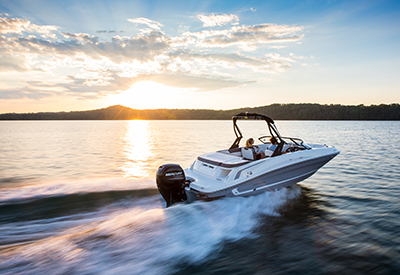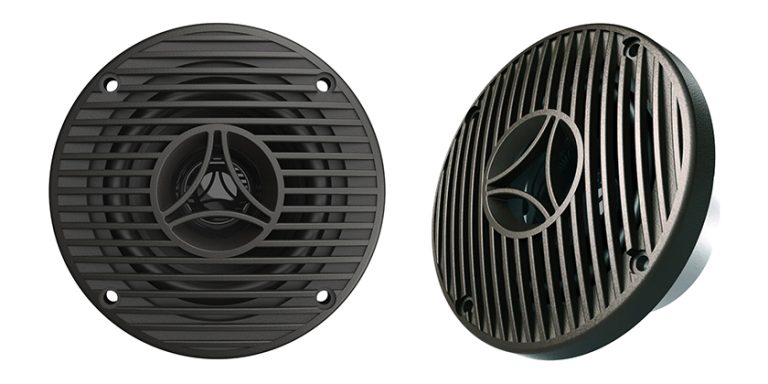Marine Electronics – Staying Connected in 2023
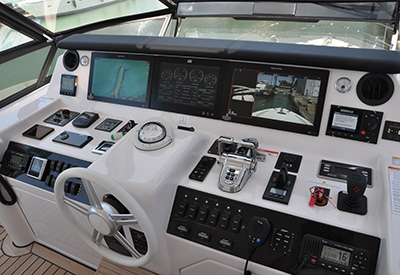
By Andy Adams
This is the simply fabulous helm on the flying bridge of the brand new Neptunus 650F. What you’re seeing here is a large console with a centre helm position, custom white leather wrapped steering wheel and a simply wonderful arrangement of controls. Triple multifunction displays are set up with the Caterpillar diesel engine information directly ahead of the driver and then two big Raymarine displays flanking that. This boat has cartography, digital switching, camera feeds from all around the boat including in the engine room, autopilot, sonar and radar, control of the sound system and more. Read the full review of the Neptunus 650F in the December 2022 issue of Canadian Yachting magazine.
The world of marine electronics is just on fire in terms of development. You can almost name any function that you could dream up and somebody is offering it. We are just heading into the traditional boat show season and this year there is a big difference from past years. Because of the COVID-19 pandemic, most boating enthusiasts have not had any in-person boat show exposure to the new products since 2019 or 2020. That means that there are almost three years of new products to catch up on. It’s going to be an exciting year in 2023!
Connections
Connections and connectivity are the big themes for the major marine electronics manufacturers. They would all like you to buy into their ever-growing families of products and it makes sense to do that because those product developers will ensure that you can connect to the future products within their brand to stay current for years to come.
The best example of this trend is that on October 5, 2022 Brunswick Corporation announced the establishment of Navico Group, now the marine industry’s leading supplier of integrated systems and products.
Navico Group is made up of the following brands: Ancor, Attwood, B&G, BEP, Blue Sea Systems, C-MAP, Garelick, Lenco, Lowrance, Marinco, Mastervolt, MotorGuide, Progressive Industries, ProMariner, RELiON, Simrad, and Whale.
These are in addition to their bigger brands, such as Lowrance, Simrad, and RELiON.
The portfolio includes a wide range of interconnected products – many of which feature complementary technologies with the potential to aid their mutual development in the years to come. This is a major corporate commitment to the interconnected future for boating.
Boats are only new once, and for a short time. For the thousands of readers with an older boat, perhaps one that pre-dates the digital revolution that’s powering all this new product development, you may feel like you have been left behind – that it’s too late to upgrade from analog instruments to a new digitally-driven chartplotter / multifunction display (MFD) for example. In fact, new developments have actually opened the door for boats from 1999 or even older, to upgrade in many different ways.
I’m talking about a new product that just won the NMEA Technology Award at the 2022 National Marine Electronics Association (NMEA) Conference. It’s the SmartBoat system by AirMar.
 AirMar SmartBoat system and cellular set-up app.
AirMar SmartBoat system and cellular set-up app.
AirMar’s NMEA 2000 certified SmartBoat system is affordable, (under $2,000 Cdn plus installation) and it’s a system for integrating your existing sensors for information like engine data and battery health, to upgraded electronics. In other words, your old equipment can connect through the SmartBoat system to drive new MFDs and other equipment. It translates any sensor protocol to NMEA2000 for display on your MFD. It’s a scalable, easily configured management solution for all marine-sensor protocols and network types. Multiple analog sensors, such as thermistors, resistive senders, binary switches, relays, run detectors and more, can be connected directly to the SmartBoat module and are easily recognized, regardless of their protocols. Connected sensors can then be configured by your marine technician – or by you if you have that kind of IT knowledge.
There’s a lot more to it, but with the SmartBoat system, you can upgrade your dashboard to integrate new equipment like the latest MFDs, sonar, radar and other equipment featured in this story. You don’t have to start all over again and with AirMar’s SmartBoat, you can keep adding to your existing boat and upgrading over the coming years thanks to the connections the SmartBoat system facilitates.
Getting connected for safety first
Standard Horizon HX 890
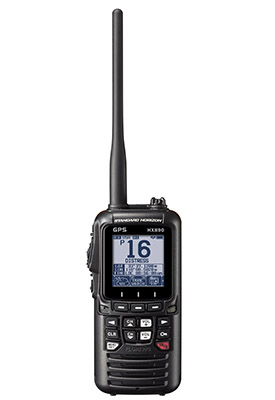
For obvious safety reasons, we need to start with the VHF radio because that’s the best way to connect to help in an emergency. There are many different VHF radios available as both fixed-mount to install at your helm and portable handsets as well. One of the portable VHF radios that we especially like is the Standard Horizon HX 890, a high-end, floating Class H DSC (digital selective calling) VHF/GPS that even has a scrambler system for secure communications on the water. This has switchable daytime / nighttime modes, waypoint and route navigation and a group monitor function using a DSC Group position call. Canadian Retail about $275.

Icom M510
For those looking for a fixed mount VHF that has the latest tech but hits at a mid-range price, the Icom M510 has a space-saving design and you can use the controls on the set or run it from your smart-phone using Wi-Fi. So, there is “connectivity” appearing again! Retail price in Canada approximately $750.
Connecting with Wi-Fi and Cellular
We all are connected through our cell phones and we know it does everything from calling friends to playing our favourite music. We are also seeing more and more people loading cartography onto their phones and navigating that way.
At Canadian Yachting magazine, we always advocate using proper charts and cartography. Your cell phone was not designed for serious navigation. Having a nice big daylight viewable screen with dedicated marine cartography is the right thing to do. But if you insist on using your phone, get a signal booster. Since 2013, Glomex has offered Wi-Fi boosters and today, they offer two different antenna options; both are around a thousand to $1,200. DIY installation is within easy reach although you will need 12-volt power connections.
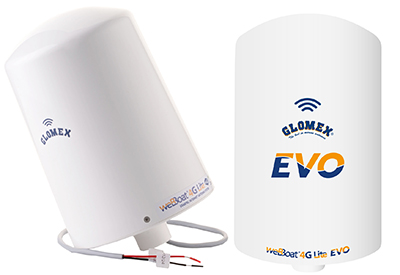
Glomex weBBoat 4G Lite EVO US
Once limited to larger vessels, web access is now readily available to smaller boats with various Wi-Fi and cellular signal boosters. For example, the innovative Glomex weBBoat® 4G Lite EVO US antenna from GA Communications is compact and lightweight. It receives 3G/4G cellular and Wi-Fi signals up to 15 miles from shore and distributes them throughout the vessel using its integrated router. Your cell phone on its own has probably less than a 5-mile range.
With the Glomex weBBoat 4G Lite EVO US, up to 24 individual devices can securely connect to the Internet simultaneously at speeds up to 72 Mbps. Designed for real-world usage, if the antenna is connected to a shoreside Wi-Fi and the boat moves out of that signal range, it automatically switches over to cellular data. Users won’t notice the seamless transition and don’t have to reconnect to the router.
A cellular plan is needed for offshore connectivity but with automatic APN, it’s simple to add a single SIM card from Telus or Rogers in Canada and connect it without any programming. The router also features LAN and WAN ports to expand its onboard adaptability.
At only 8″ H x 5.5″ diameter and just 2 pounds., the UV-resistant radome easily fits on a coach roof, radar arch, or spreader. A video is at www.bit.ly/weBBoat4GLiteEVO .
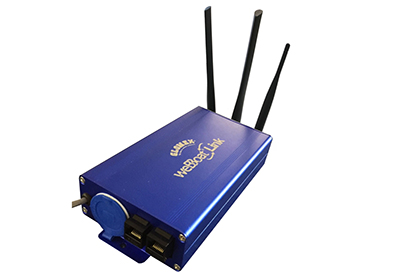
The Glomex weBBoat® Link IT1304/US antenna
Glomex has a second choice as well. For the latest fishing update or simply posting a selfie, you can use the new weBBoat® Link IT1304/US antenna from Glomex, it’s easy to get 4G Wi-Fi web access up to 10 miles from shore.
WeBBoat Link is a single SIM system. Beyond the powerful 42 Mbps download Wi-Fi signal it provides, it has two Ethernet ports to connect onboard systems and PCs to the Internet. A video is at www.bit.ly/WeBBoatLink .
VSAT and Satellite
If a 15-mile range doesn’t cover your cruising plans, or if you are heading into remote places like the Pacific Northwest, Lake Superior or isolated sun destinations, you will want a satellite solution.
There are two companies you might want to investigate; Intellian and KVH. There are significant hardware and installation costs to get a satellite system onboard, and then you subscribe to various levels of service depending on your needs, but with a system like this, you can stay connected almost anywhere.
We spoke at length to the folks at KVH because their new hybrid systems are the most affordable in this admittedly rarified sector.

KVH TracNet H30
For Canadian Yachting readers with larger boats or larger cruising plans, the KVH TracNet H30 looks like a great choice. You get three types of connectivity in one dome; satellite, cellular and Wi-Fi over the KVH ONE hybrid network. This can keep you connected to the best communications at all times, in all sea conditions and at any boat speed.
The people at KHV pointed out that people just want things to work. The hybrid system lets the user do what they want while the system automatically switches to the strongest as well as the most economical signal. Other features that yacht owners truly value include having two voice lines with option for an additional eight virtual local numbers for incoming calls. It’s worth mentioning that KVH offers an end-to-end solution with the hardware, airtime, service and support.
Enterprise-grade cybersecurity and integrated firewalls are available options as are cloud-based email, vessel tracking and more.
The KVH system comes with their own SIM card, you can insert your own SIM card into the system if that is an economic advantage. The cost of a TracNet H30 in Canadian dollars would be around $27,000 with an installation cost of perhaps $3,500 and then you become a subscriber. A Leisure Rate plan with 200 megabytes might be $159 a month US. There is a web tool that let’s you determine what your usage might be to manage the system best: https://www.kvh.com/landing-pages/understanding-your-data .
Upgrade to a new Multifunction Display
Gone are the traditional dazzling dashboards of instruments with chrome bezels and swinging needles. However, many of the new daylight viewable MFD displays can be configured graphically to show traditional tachometers, oil pressure and volts – anything you used to have and that your engine or mechanical systems has a sender for. Make them big and full screen. Pinch them down to a small inset within a greater map display, camera feed or radar screen.
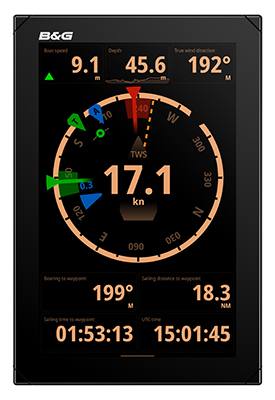
Some call these MFDs chartplotters and displaying your navigation charts is perhaps the single most frequently used function, but many have integrated sonar systems displaying the sea below you and hopefully, the school of fish. Many can split screen two or more functions at once and with the right systems, you can even have digital switching for everything – turn on the lights or blast the tunes all from a digital icon on your MFD.
Some systems, like the B&G Nemesis are specially geared for sailors with GPS, charts, wind, depth and speed for the best in sailing performance.
B&G Nemesis
Featuring a very bright IPS SolarMax HD touchscreen, B&G’s Nemesis has super-wide viewing angles to let you see the screen clearly from almost anywhere onboard, even wearing polarized sunglasses. B&G’s unique sailing features helps you maximize your time onboard. For example, the SailSteer function combines your instrument data in one easy-to-view screen.
RacePanel gives you all the information you need to nail the start every time while Laylines and Sailing Time features optimize upwind performance and WindPlot tracks the windshifts to make sure you are on the inside of every lift. Nemesis is the next generation of intelligent sailing displays. Canadian retail approximately $5,204 to $7,944.
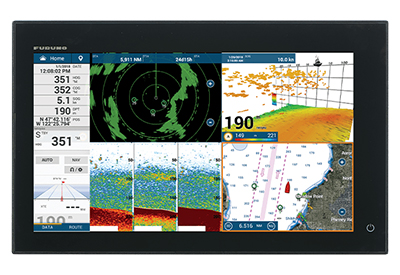
Furuno NavNet TZtouch3 TZT16F
Geared for the avid angler, we like the Furuno NavNet TZtouch3 TZT16F for the edge-to-edge glass display that delivers clear images from any angle and for the speed of response from the quad-core processor. The edge-swipe and single tap menu options keep it simple and fast to use. This MFD includes built-in Dual Channel 1kWTruEcho CHIRP and CW Fish Finder too. With special appeal for fishing, all TZtouch3 models include Furuno’s Fish-it & Drift-it to help you locate the correct spot to start your drift so you will pass right over your fishing point. Furuno’s NavNet TZtouch3 series includes the 16-inch TZT16F, 9-inch TZT9F and 12-inch TZT12F models with hybrid control. Canadian retail approximately $ (info requested)

Garmin GPS Map 8400 / 8600 Series
Available in sizes ranging from 10-inch all the way up to 24-inch, Garmin’s GPS Map series of touchscreen chartplotters include full in-plane switching displays, support for traditional scanning and the Garmin Panoptix Sonars as well as their preloaded coastal charts and inland maps featuring Navionics data with auto guidance technology. These chartplotters can be mounted on a bracket in a housing as a separate piece of equipment for upgrading an older boat, or they can be built flush into the dashboard. Canadian retail approximately $3599 up to $16,899.

Raymarine Axiom Series
Raymarine’s Axiom series multifunction displays run on their LightHouse 3 operating system and for cruising, LightHouse gives you the choice of a fluid touch-screen or a HybridTouch user experience that makes navigating as simple as using your smartphone. Starting with the Axiom 7 and going up to the Axiom 12, each Axiom is expandable, so its capabilities can grow as needed. It supports the full range of Raymarine accessories, including Quantum radar, CHIRP Sonar, FLIR thermal cameras, audio integration, instruments, cameras, and Evolution autopilot. Standard Wi-Fi and Bluetooth connectivity allows connection to the latest Raymarine apps for tablets and smartphones.
Axiom includes surface and trunnion mounting kits, mounting hardware, power/data cable, and installation instructions. Canadian retail pricing will range from about $1,100 for the Axiom 7 to $3,400 for the 12.
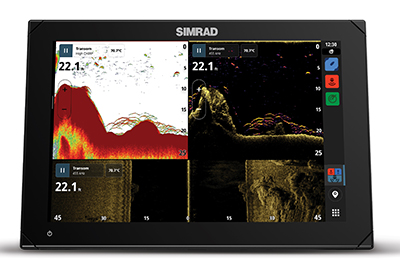
Simrad NSX Series
The NSX chartplotter and fishfinder is a new mid-range product family in the Simrad line of MFDs. With an innovative interface featuring powerful navigation capability with C-MAP support, you can see everything like never before. The NSX features integrated sonar, radar and autopilot systems capability. Using their handy Setup Wizard tool, you can be up and running in no time and better equipped for your next adventure. Canadian retail starts at approximately $1,439 for the 7-inch basic (no transducer) to the 12-inch NSX 3012 with Active Imaging at $4,109
In Conclusion
Once you have set your boat up with a suitable system and you have considered the functions that will be most useful to you, head to the boat show and spend some time checking out the various functions and features each one offers.
Sonar is very useful in unfamiliar waters or if you are into fishing. There are probably more sonar and “fishfinder” systems on the market than almost any other type of equipment and it’s a very competitive space. Prices start at surprisingly low levels for smaller fishing boats and the screens are still daylight viewable and deliver good detail.
Another upgrade that’s worth its weight in gold the first time you get caught in fog is a radar system. Once you have a good MFD at the helm, you can add a broadband radar for prices starting under $4,000. The safety a radar system provides is something that you need to experience to appreciate.
In the coming issues of Canadian Yachting, we will delve more into radar and its benefits. Stay tuned for that and enjoy searching through the boat shows this winter!




